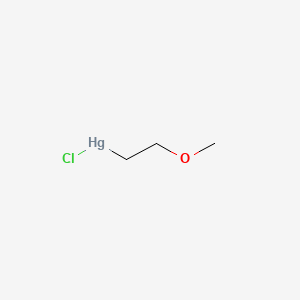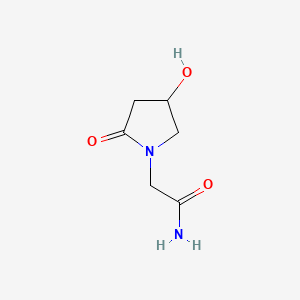
奥拉西坦
概述
描述
Oxiracetam, chemically known as 4-hydroxy-2-oxo-1-pyrrolidineacetamide, is a nootropic compound belonging to the racetam family. It was developed in the 1970s and is renowned for its cognitive-enhancing properties, including improvements in memory, learning, and focus. Unlike some other nootropics, oxiracetam also exhibits mild stimulant effects, making it a popular choice for those seeking cognitive enhancement without significant side effects .
科学研究应用
Chemistry: Used as a model compound to study the behavior of racetams and their derivatives.
Biology: Investigated for its effects on neurotransmitter systems and synaptic plasticity.
Medicine: Explored for its potential in treating cognitive impairments, including dementia and Alzheimer’s disease.
Industry: Utilized in the development of cognitive-enhancing supplements and pharmaceuticals.
作用机制
Target of Action
Oxiracetam primarily targets key neurotransmitter systems in the brain, particularly glutamate and acetylcholine . These neurotransmitters play a crucial role in cognitive processes such as memory formation, learning, and focus .
Mode of Action
Oxiracetam interacts with its targets by modulating the release of these neurotransmitters . It is also thought to involve the modulation of neurotransmitter receptors in the brain, including AMPA and NMDA receptors . These receptors play a key role in synaptic transmission and are critical for learning and memory processes .
Biochemical Pathways
Oxiracetam affects several biochemical pathways. It has been shown to regulate ATP metabolism, glutamine-glutamate, and antioxidants in the cortex region of hypoperfused rats . It also influences the transient receptor potential canonical (TRPC)6 neuron survival pathway . This pathway plays a significant role in the protective effect of oxiracetam treatments on acute cerebral ischemia/reperfusion injury .
Pharmacokinetics
Oxiracetam is well absorbed from the gastrointestinal tract with a bioavailability of 56-82% . Peak serum levels are reached within one to three hours after a single 800 mg or 2000 mg oral dose . The maximal serum concentration reaches between 19 and 31 μg/ml at these doses . Oxiracetam is mainly cleared renally and approximately 84% is excreted unchanged in the urine . The half-life of oxiracetam in healthy individuals is about 8 hours , whereas it is 10–68 hours in patients with renal impairment .
Result of Action
Oxiracetam has been shown to have neuroprotective effects. It reduces damage to neurons and white matter, restores blood flow, and blocks the activation of cells usually associated with scarring the brain . This leads to cognitive benefits related to spatial learning and improved memory . It also suppresses the activation of microglia, decreases the production of inflammatory molecules and nitric oxide (NO) in microglia, and protects neurons against indirect toxicity mediated by amyloid beta-treated microglia cell-conditioned medium .
Action Environment
Oxiracetam’s action, efficacy, and stability can be influenced by environmental factors. For instance, it has been found to be effective in treating cognitive impairments caused by cerebral hypoperfusion . It is also known to penetrate the blood-brain barrier and reach the hippocampus and cerebral cortex with a high concentration . .
生化分析
Biochemical Properties
Oxiracetam modulates the glutamatergic system, which plays a key role in memory and learning processes . It enhances the release of excitatory neurotransmitters . Oxiracetam is chemically similar to Piracetam, both sharing the 2-Pyrrolidone nucleus . Oxiracetam features an additional hydroxy group, making it unique .
Cellular Effects
Oxiracetam has been shown to have significant effects on various types of cells and cellular processes. For instance, it has been found to curtail the size of ischemic penumbra in neonatal mice experiencing hypoxic-ischemic brain damage (HIBD), thereby reducing infarction . It also switches the polarization of microglia from the inflammatory towards the alternatively activated phenotype, promoting microglia from being neurotoxic into neuroprotective .
Molecular Mechanism
Oxiracetam exerts its effects at the molecular level through several mechanisms. It promotes autophagy through the AMPK/mTOR pathway, which further induces the transition of the inflammatory to the alternatively activated phenotype in microglia . The pro-inflammatory factors secretion is inhibited as well, thereby reducing the progression of the infarction .
Temporal Effects in Laboratory Settings
In laboratory settings, Oxiracetam has been observed to have long-term effects on cellular function. For instance, it has been found to reduce the expansion of ischemic infarction in part via regulating the interplay between microglia activation and autophagy .
Dosage Effects in Animal Models
In animal models, Oxiracetam has been found to very reliably and potently prevent amnesia induced by a variety of anti-cholinergic or anti-glutaminergic compounds (injections of 3-30mg/kg in rats pretty much normalizing memory formation) .
Transport and Distribution
Oxiracetam is well absorbed from the gastrointestinal tract with a bioavailability of 56-82% . It is mainly cleared renally and approximately 84% is excreted unchanged in the urine .
准备方法
Synthetic Routes and Reaction Conditions: Oxiracetam can be synthesized through several methods. One common route involves the reaction of 2-oxo-pyrrolidine with ethyl chloroacetate, followed by hydrolysis and subsequent reaction with hydroxylamine to yield oxiracetam. The reaction conditions typically involve controlled temperatures and pH levels to ensure high yield and purity .
Industrial Production Methods: Industrial production of oxiracetam often employs large-scale batch reactors where the synthesis is carried out under optimized conditions to maximize yield and minimize impurities. The process includes steps such as crystallization and purification to obtain the final product with high purity suitable for pharmaceutical use .
化学反应分析
Types of Reactions: Oxiracetam undergoes various chemical reactions, including:
Oxidation: Oxiracetam can be oxidized to form corresponding oxo derivatives.
Reduction: Reduction reactions can convert oxiracetam into its reduced forms.
Substitution: Nucleophilic substitution reactions can occur at the acetamide group.
Common Reagents and Conditions:
Oxidation: Common oxidizing agents include potassium permanganate and hydrogen peroxide.
Reduction: Reducing agents such as lithium aluminum hydride are used.
Substitution: Nucleophiles like amines and alcohols can be used under basic conditions.
Major Products: The major products formed from these reactions include various derivatives of oxiracetam, which can be further studied for their pharmacological properties .
相似化合物的比较
Oxiracetam is often compared with other racetams, such as:
Piracetam: The first racetam developed, known for its cognitive-enhancing effects but less potent than oxiracetam.
Aniracetam: Similar to oxiracetam but also has anxiolytic properties.
Phenylpiracetam: More potent than oxiracetam and has stimulant effects.
Uniqueness of Oxiracetam: Oxiracetam stands out due to its balanced profile of cognitive enhancement and mild stimulation without significant side effects. Its ability to modulate multiple neurotransmitter systems and receptor pathways makes it a versatile nootropic .
属性
IUPAC Name |
2-(4-hydroxy-2-oxopyrrolidin-1-yl)acetamide | |
|---|---|---|
| Source | PubChem | |
| URL | https://pubchem.ncbi.nlm.nih.gov | |
| Description | Data deposited in or computed by PubChem | |
InChI |
InChI=1S/C6H10N2O3/c7-5(10)3-8-2-4(9)1-6(8)11/h4,9H,1-3H2,(H2,7,10) | |
| Source | PubChem | |
| URL | https://pubchem.ncbi.nlm.nih.gov | |
| Description | Data deposited in or computed by PubChem | |
InChI Key |
IHLAQQPQKRMGSS-UHFFFAOYSA-N | |
| Source | PubChem | |
| URL | https://pubchem.ncbi.nlm.nih.gov | |
| Description | Data deposited in or computed by PubChem | |
Canonical SMILES |
C1C(CN(C1=O)CC(=O)N)O | |
| Source | PubChem | |
| URL | https://pubchem.ncbi.nlm.nih.gov | |
| Description | Data deposited in or computed by PubChem | |
Molecular Formula |
C6H10N2O3 | |
| Source | PubChem | |
| URL | https://pubchem.ncbi.nlm.nih.gov | |
| Description | Data deposited in or computed by PubChem | |
DSSTOX Substance ID |
DTXSID9045180 | |
| Record name | 4-Hydroxy-2-oxo-1-pyrrolidineacetamide | |
| Source | EPA DSSTox | |
| URL | https://comptox.epa.gov/dashboard/DTXSID9045180 | |
| Description | DSSTox provides a high quality public chemistry resource for supporting improved predictive toxicology. | |
Molecular Weight |
158.16 g/mol | |
| Source | PubChem | |
| URL | https://pubchem.ncbi.nlm.nih.gov | |
| Description | Data deposited in or computed by PubChem | |
CAS No. |
62613-82-5 | |
| Record name | Oxiracetam | |
| Source | CAS Common Chemistry | |
| URL | https://commonchemistry.cas.org/detail?cas_rn=62613-82-5 | |
| Description | CAS Common Chemistry is an open community resource for accessing chemical information. Nearly 500,000 chemical substances from CAS REGISTRY cover areas of community interest, including common and frequently regulated chemicals, and those relevant to high school and undergraduate chemistry classes. This chemical information, curated by our expert scientists, is provided in alignment with our mission as a division of the American Chemical Society. | |
| Explanation | The data from CAS Common Chemistry is provided under a CC-BY-NC 4.0 license, unless otherwise stated. | |
| Record name | (+-)-Oxiracetam | |
| Source | ChemIDplus | |
| URL | https://pubchem.ncbi.nlm.nih.gov/substance/?source=chemidplus&sourceid=0062613825 | |
| Description | ChemIDplus is a free, web search system that provides access to the structure and nomenclature authority files used for the identification of chemical substances cited in National Library of Medicine (NLM) databases, including the TOXNET system. | |
| Record name | Oxiracetam | |
| Source | DrugBank | |
| URL | https://www.drugbank.ca/drugs/DB13601 | |
| Description | The DrugBank database is a unique bioinformatics and cheminformatics resource that combines detailed drug (i.e. chemical, pharmacological and pharmaceutical) data with comprehensive drug target (i.e. sequence, structure, and pathway) information. | |
| Explanation | Creative Common's Attribution-NonCommercial 4.0 International License (http://creativecommons.org/licenses/by-nc/4.0/legalcode) | |
| Record name | 4-Hydroxy-2-oxo-1-pyrrolidineacetamide | |
| Source | EPA DSSTox | |
| URL | https://comptox.epa.gov/dashboard/DTXSID9045180 | |
| Description | DSSTox provides a high quality public chemistry resource for supporting improved predictive toxicology. | |
| Record name | 2-(4-hydroxy-2-oxopyrrolidin-1-yl)acetamide | |
| Source | European Chemicals Agency (ECHA) | |
| URL | https://echa.europa.eu/information-on-chemicals | |
| Description | The European Chemicals Agency (ECHA) is an agency of the European Union which is the driving force among regulatory authorities in implementing the EU's groundbreaking chemicals legislation for the benefit of human health and the environment as well as for innovation and competitiveness. | |
| Explanation | Use of the information, documents and data from the ECHA website is subject to the terms and conditions of this Legal Notice, and subject to other binding limitations provided for under applicable law, the information, documents and data made available on the ECHA website may be reproduced, distributed and/or used, totally or in part, for non-commercial purposes provided that ECHA is acknowledged as the source: "Source: European Chemicals Agency, http://echa.europa.eu/". Such acknowledgement must be included in each copy of the material. ECHA permits and encourages organisations and individuals to create links to the ECHA website under the following cumulative conditions: Links can only be made to webpages that provide a link to the Legal Notice page. | |
| Record name | OXIRACETAM | |
| Source | FDA Global Substance Registration System (GSRS) | |
| URL | https://gsrs.ncats.nih.gov/ginas/app/beta/substances/P7U817352G | |
| Description | The FDA Global Substance Registration System (GSRS) enables the efficient and accurate exchange of information on what substances are in regulated products. Instead of relying on names, which vary across regulatory domains, countries, and regions, the GSRS knowledge base makes it possible for substances to be defined by standardized, scientific descriptions. | |
| Explanation | Unless otherwise noted, the contents of the FDA website (www.fda.gov), both text and graphics, are not copyrighted. They are in the public domain and may be republished, reprinted and otherwise used freely by anyone without the need to obtain permission from FDA. Credit to the U.S. Food and Drug Administration as the source is appreciated but not required. | |
Synthesis routes and methods I
Procedure details







Synthesis routes and methods II
Procedure details





Synthesis routes and methods III
Procedure details




Synthesis routes and methods IV
Procedure details





Retrosynthesis Analysis
AI-Powered Synthesis Planning: Our tool employs the Template_relevance Pistachio, Template_relevance Bkms_metabolic, Template_relevance Pistachio_ringbreaker, Template_relevance Reaxys, Template_relevance Reaxys_biocatalysis model, leveraging a vast database of chemical reactions to predict feasible synthetic routes.
One-Step Synthesis Focus: Specifically designed for one-step synthesis, it provides concise and direct routes for your target compounds, streamlining the synthesis process.
Accurate Predictions: Utilizing the extensive PISTACHIO, BKMS_METABOLIC, PISTACHIO_RINGBREAKER, REAXYS, REAXYS_BIOCATALYSIS database, our tool offers high-accuracy predictions, reflecting the latest in chemical research and data.
Strategy Settings
| Precursor scoring | Relevance Heuristic |
|---|---|
| Min. plausibility | 0.01 |
| Model | Template_relevance |
| Template Set | Pistachio/Bkms_metabolic/Pistachio_ringbreaker/Reaxys/Reaxys_biocatalysis |
| Top-N result to add to graph | 6 |
Feasible Synthetic Routes
体外研究产品的免责声明和信息
请注意,BenchChem 上展示的所有文章和产品信息仅供信息参考。 BenchChem 上可购买的产品专为体外研究设计,这些研究在生物体外进行。体外研究,源自拉丁语 "in glass",涉及在受控实验室环境中使用细胞或组织进行的实验。重要的是要注意,这些产品没有被归类为药物或药品,他们没有得到 FDA 的批准,用于预防、治疗或治愈任何医疗状况、疾病或疾病。我们必须强调,将这些产品以任何形式引入人类或动物的身体都是法律严格禁止的。遵守这些指南对确保研究和实验的法律和道德标准的符合性至关重要。
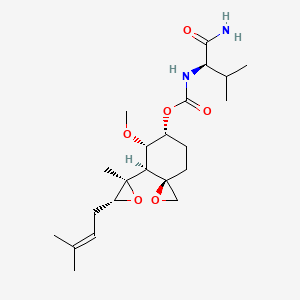
![2-(Chloromethyl)-5-(4-fluorophenyl)thieno[2,3-d]pyrimidin-4-ol](/img/structure/B1677975.png)
![(1S,5S)-(1-{5-[(4-amino-benzenesulfonyl)-isobutyl-amino]-6-phosphonooxy hexylcarbamoyl}-2,2-diphenyl-ethyl)-carbamic acid methyl ester](/img/structure/B1677976.png)
![2-[4-(2,3-dimethylphenyl)piperazin-1-yl]-N-(2-ethoxyphenyl)acetamide](/img/structure/B1677980.png)
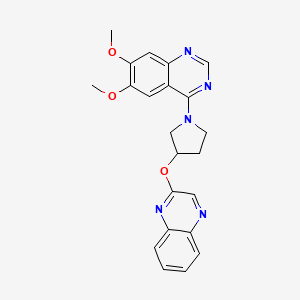
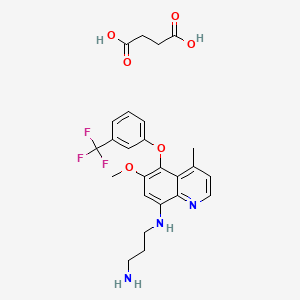
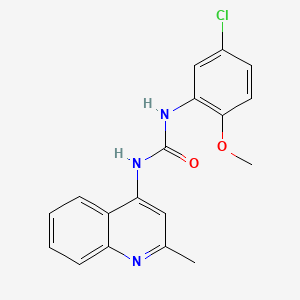
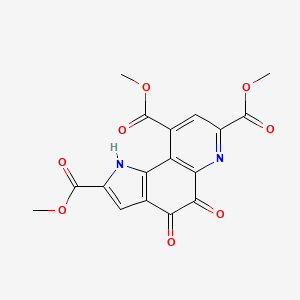
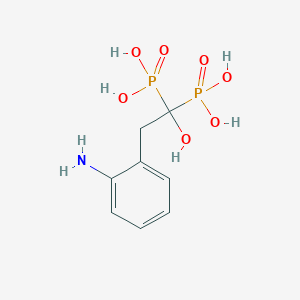
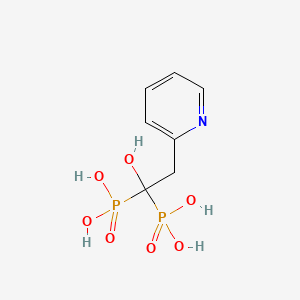
![P,P'-[1-Hydroxy-2-(4-pyridinyl)ethylidene]bis-phosphonic Acid](/img/structure/B1677990.png)
![[1-Hydroxy-3-(pyridin-3-yl)propane-1,1-diyl]bis(phosphonic acid)](/img/structure/B1677991.png)
![{[(3-Methylpyridin-2-Yl)amino]methanediyl}bis(Phosphonic Acid)](/img/structure/B1677993.png)
